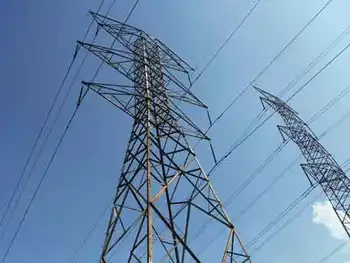‘Smart’ power meters are the future
By Associated Press
NFPA 70e Training
Our customized live online or in‑person group training can be delivered to your staff at your location.

- Live Online
- 6 hours Instructor-led
- Group Training Available
But the key to maximum savings — as much as 6 percent a month last summer — was his grasp of the state of the electrical grid and his family's willingness to adjust their power usage accordingly.
His utility, PPL Corp., is among a growing number of electricity providers that are testing pricing plans in which rates are set higher during the hours of peak demand, roughly following the curves of supply and demand in the wholesale energy markets.
As more utilities install "smart" power meters that track how much electricity flows into a home in real time, they are freer to offer alternatives to the average monthly rate that they traditionally charged to consumers.
The pilot programs are the first step in what's expected to be a complete transformation of the century-old power grid. Once a silent supplier of electrons to homes and businesses, it's gaining the ability to talk back — not only to power companies, but to consumers and their appliances.
Armed with information, Brubaker, 56, took action. Besides switching his lamps to energy-saving compact fluorescent light bulbs, he chose to run his pool pump and dishwasher at night at his home in the suburbs and dairy country of south-central Pennsylvania.
"Essentially, it was just more conservation, being more cognizant of, 'Yes there are more savings here if we do things differently,'" Brubaker said.
By signing up tens of millions of people like Brubaker to change patterns of electric usage, the companies expect the new power meters and time-based rates to help avoid blackouts, curb greenhouse gas emissions and beat back the immediate need to build expensive new power plants.
Many utilities hope to make such rates available to all their customers within several years, with an eye toward shaving usage on the most demanding days of the year when electricity prices rise sharply.
While major industrial and commercial ratepayers have operated on time-based rates for years, the concept remains relatively foreign to residential users.
Various kinds of smart meters are available and in use around the country. Depending on its capabilities, a smart meter — at a cost of about $200 per home — also can play a role in how much information about energy use is made available to customers and how much money can be saved. The most advanced ones allow the utility and the customer to gauge usage and cost immediately, instead of once a month after a meter reader makes the rounds.
Utilities plan to offer a menu of rate plans. In its pilot, PPL offered something referred to as a "time-of-use" rate, where set periods of higher prices contrast with periods of lower prices. In this case, pilot participants paid more between noon and 7 p.m. on weekdays and less the rest of the time.
Some rates, called "real time," change throughout the day as the wholesale price floats up and down. People who sign up for such plans may receive signals, such as e-mails or cell phone messages, to tell them prices are climbing dangerously.
"Critical peak" rates would apply only on the dozen or more highest-demand days of the year.
So far, pilot programs have found that the average customer usually saves money. Critics note, however, that's not always the case.
In the pilot program Brubaker signed up for the past three summers, about one in four PPL customers accumulated bigger bills than they would have logged on the average rate. PPL officials chalked that up to people flying blind without enough information about how to save money, a shortcoming the utility is trying to address by things like putting a kilowatt calculator on its Web site.
In a Commonwealth Edison Co. pilot program in Illinois, the average participant paid about 7 percent more in 2005, a departure from the pilot tests of other years. Company officials blamed the increase on spiking prices during an unusually hot summer and the disruption of natural gas supplies caused by Hurricane Katrina.
Last year, about 95 percent of the participants saved money in Commonwealth Edison's open-enrollment residential real-time pricing program, thought to be the nation's first. The majority saved between 7 percent to 12 percent, the utility said. To date, about 4,000 of the utility's 3.3 million residential customers have signed up.
A brochure the utility mailed to customers advises the program might not be for them if, for instance, they don't work during the day, don't have electric heat or have a medical condition.
Some electricity consumers simply don't have much wiggle room when it comes to changing electricity consumption. For instance, families with small children who participated in an Ottawa Hydro pilot in 2006-07 later reported difficulty shaping their lives around the rates. They told surveyors that it was difficult to cut back on laundry loads during the higher-priced daytime periods.
Some consumer advocates remain skeptical. They warn that smart meters and fluctuating rates could be a multibillion dollar mistake that would shift people from the relative stability of an averaged, monthly rate and subject them to the unpredictable swings of the wholesale electricity market.
In Washington, D.C., ratepayer advocate Elizabeth A. Noel urged public service commissioners to ensure the $60 million smart-meter proposal by Potomac Electric and Power Co. will guarantee cost benefits before the utility can bill customers to recoup its investment plus a rate of return.
The testing ground will be a $2 million pilot set to begin in June, to be paid for by the utility.
"If you don't show consumers that there's something in it for them, then they're not going do to it," Noel said. "You have to show people what it means to them, and people look at the bottom line of their electric bills."
Gerald A. Norlander, the executive director of the Public Utility Law Project in Albany, N.Y., said that passing along the volatile price of wholesale electricity could shut down factories and devastate households. And he suggested that power plant owners could circumvent any conservation efforts by manipulating the supply of electricity to keep prices high.
Jon Wellinghoff, a member of the Federal Energy Regulatory Commission who advocates smart meters, countered that his agency and state regulators will be closely watching to guard against market manipulation.
Utility officials say they do not expect such time-based rates to become mandatory for most ratepayers. Some utilities may offer their ratepayers incentives to enroll, like rebates, discounts and temporary guarantees against paying more.
"There will be benefits to everyone, but without the technology, it won't happen," said Dennis Wraase, the chief executive of Pepco Holdings Inc., which wants to install smart meters for the nearly 2 million customers under its three utilities in Washington, D.C., and the mid-Atlantic.
After all the changes he made, Brubaker, the PPL customer, said shutting off the pool pump during the day made the biggest impact: The swimming pool never warmed up. "As far as hardships go," he said, "I can live with that one."











